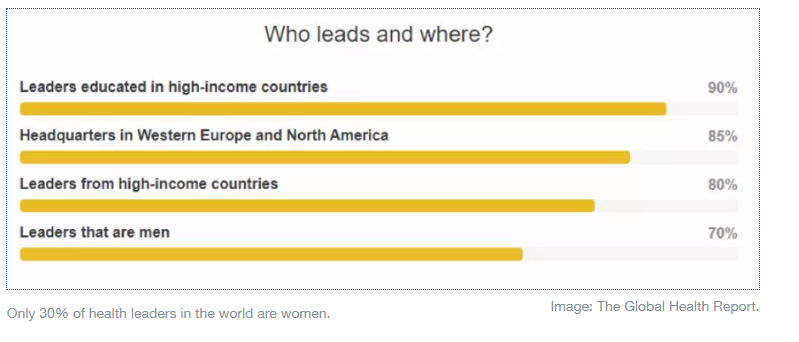by Emma Charlton*
-A review of the global health system, the Global Health 50/50 report, shows disparities in leadership which could impact policies and priorities.
-More than 70% of leaders in the sector are men.
-More than 80% are nationals of high-income countries.
-Women make up 70% of workers and only 5% of leadership positions. It may take more than 50 years to see gender parity at senior levels.
Global health is a system that’s neither fair nor fit-for-purpose.
That’s according to a report that found more than 70% of its leaders are men, more than 80% are nationals of high-income countries and more than 90% were educated in high-income countries. The findings are also timely since women comprise the majority of health and social care workers, and as such, are on the frontlines of the fight against COVID-19.
While women make up 70% of workers, only 5% of leadership positions are occupied by women from low- and middle-income countries, and power is concentrated in rich countries, said the authors of the Global Health 50/50 report, published by University College London’s Institute for Global Health.
“The current global health system is failing to embrace gender diversity and respond to gender inequalities,” says Michelle Bachelet, United Nations High Commissioner for Human Rights and former President of Chile. “The report forecasts that it could take more than 50 years to see gender parity at the senior levels of these organizations – another half century is too long to wait.”
Health is lagging behind other sectors
This matters because it translates into misaligned global priorities and a lack of action on addressing gender norms – despite the role gender plays in driving health inequities, the report says.
The disparity is all the more apparent when contrasted to the progress women are making in other fields and sectors. While the World Economic Forum’s Global Gender Gap Report 2020 shows there is still a substantial worldwide gender gap that needs to be closed, its ’Health and Survival’ gauge (which measures access to health services) is more positive.
Even so, the Global Gender Gap report shows differences between countries. Forty-eight have achieved near-parity, another 71 countries have closed at least 97% of the gap, and nine countries have yet to close more than 4% of their gap.

Four large countries – Pakistan (94.6%); India (94.4%); Viet Nam (94.2%) and China (92.6%) – trail behind, which means that millions of women in these and other countries are not yet granted the same access to health as men, the Forum report says.
Change is not coming fast enough
The two reports agree that recent progress in closing the gap has not been rapid enough. The Global Health 50/50 report shows that from 2018 to 2020, the total number of female CEOs increased by just one (from 41 to 42, out of 139 CEOs in total).
“This isn’t merely a result of slow turnover at the top,” it says. “On average, one in five organizations under review welcome a new CEO each year ... Simply, men continue to be succeeded by other men.”
Only 28% of senior management teams have reached gender parity, up from 25% in 2018. At the current rate, we will not reach gender parity in senior management across global health organisations until 2074.
“We need to mobilize across the world – peacefully and powerfully – to advance on rights, dignity and diversity for everyone,” the UN’s Bachelet says. “By shining a light on equality- and gender-related practices in global health, Global Health 50/50 reminds us that the health sector needs to lead and advances a powerful incentive for change in this urgent struggle.”
*Senior Writer, Formative Content
**first published in: www.weforum.org




 By: N. Peter Kramer
By: N. Peter Kramer

